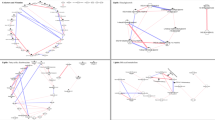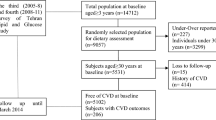Abstract
Background: Although alcohol intake has been positively associated with breast cancer risk in epidemiologic studies, the mechanisms mediating this association are speculative.
Objective: The Postmenopausal Women's Alcohol Study was designed to explore the effects of moderate alcohol consumption on potential risk factors for breast cancer. In the present analysis, we evaluated the relationship of alcohol consumption with antioxidant nutrients and a biomarker of oxidative stress.
Design: Participants (n=53) consumed a controlled diet plus each of three treatments (15 or 30 g alcohol/day or a no-alcohol placebo beverage), during three 8-week periods in random order. We measured the antioxidants, vitamin E (alpha (α)- and gamma (γ)-tocopherols), selenium, and vitamin C in fasting blood samples which were collected at the end of diet periods, treated and frozen for assay at the end of the study. We also measured 15-F2t-IsoP isoprostane, produced by lipid peroxidation, which serves as an indicator of oxidative stress and may serve as a biomarker for conditions favorable to carcinogenesis.
Results: After adjusting for BMI (all models) and total serum cholesterol (tocopherol and isoprostane models) we observed a significant 4.6% decrease (P=0.02) in α-tocopherol and a marginally significant 4.9% increase (P=0.07) in isoprostane levels when women consumed 30 g alcohol/day (P=0.06 and 0.05 for overall effect of alcohol on α-tocopherol and isoprostanes, respectively). The other antioxidants were not significantly modified by the alcohol treatment.
Conclusions: These results suggest that moderate alcohol consumption increases some biomarkers of oxidative stress in postmenopausal women.
Sponsorship: NCI, NIH and ARS, USDA.
This is a preview of subscription content, access via your institution
Access options
Subscribe to this journal
Receive 12 print issues and online access
$259.00 per year
only $21.58 per issue
Buy this article
- Purchase on Springer Link
- Instant access to full article PDF
Prices may be subject to local taxes which are calculated during checkout
Similar content being viewed by others
References
Afrasyap L, Guvenen G & Turkmen S (1998): Plasma and erythrocyte total antioxidant status in patients with benign and malign breast disease. Cancer Biochem. Biophys. 16, 129–138.
Albanes DA & Hartman TJ (1999): Antioxidants and cancer: evidence from human observational studies and intervention trials. In Antioxidant Status, Diet, Nutrition and Health, ed. AM Papas, pp 497–544. London: CRC Press.
Alberg A (2002): The influence of cigarette smoking on circulating concentrations of antioxidant micronutrients. Toxicology 180, 121–137.
Ames BN, Shigenaga MK & Hagen TM (1993): Oxidants, antioxidants and the degenerative diseases of aging. Proc. Natl. Acad. Sci. USA 90, 7915–7922.
Baer D, Judd JT, Clevidence BA, Muesing RA, Campbell W, Brown ED & Taylor PR (2002): Moderate alcohol consumption lowers risk factors for cardiovascular disease in post-menopausal women fed a controlled diet. Am. J. Clin. Nutr. 75, 593–599.
Chevion S & Chevion M (2000): Antioxidant status and human health. Use of cyclic voltammetry for the evaluation of the antioxidant capacity of plasma and of edible plants. Ann. NY Acad. Sci. 899, 308–325.
Colantoni A, La Paglia N, De Maria N, Emanuele MA, Emanuele NV, Idilman R, Harig J & Van Thiel DH (2000): Influence of sex hormonal status on alcohol-induced oxidative injury in male and female rat liver. Alcohol Clin. Exp. Res. 24, 1467–1473.
Davi G, Alessandrini P, Mezzetti A, Minotti G, Bucciarelli T & Constantini F (1997): In vivo formation of 8-Epi-prostaglandin F2alpha is increased in hypercholesterolemia. Arterioscler. Thromb. Vasc. Biol. 17, 3230–3235.
Davi G, Ciabattoni G, Consoli A, Mezetti A, Folco A, Santarone S, Pennese E, Vitacolonna E, Bucciarelli T, Constantini F, Capani F & Patrono C (1999): In vivo formation of 8-iso-prostaglandin F2alpha and platelet activation in diabetes mellitus: effects of improved metabolic control and vitamin E supplementation. Circulation 99, 224–229.
Dietrich M, Block G, Hudes M, Morrow JD, Norkus EP, Traber MG, Cross CE & Packer L (2002): Antioxidant supplementation decreases lipid peroxidation biomarker F2-isoprostanes in plasma of smokers. Cancer Epidemiol. Biomark. Prev. 11, 7–13.
Dorgan JF, Judd JT, Albert P, Brown E, Corle D, Campbell WS, Baer D, Hartman T, Tejpar A, Clevidence BA, Giffen C, Chandler DW, Stanczyk FZ & Taylor PR (2001): Alcohol and serum hormone levels in postmenopausal women: results from a controlled feeding study. J. Natl. Cancer Inst. 93, 710–715.
Djuric Z, Depper JB, Uhley V, Smith D, Lababidi S, Martino S & Heilbrun LK (1998): Oxidative DNA damage levels in blood from women at high risk for breast cancer are associated with dietary intakes of meats, vegetables, and fruits. J. Am. Diet. Assoc. 98, 524–528.
Eskelson CD, Odeleye OE, Watson RR, Earnest DL & Mufti SI (1993): Modulation of cancer growth by vitamin E and alcohol. Alcohol 28, 117–125.
Gunter EW, Lewis BL & Konicikowski SM (1996): Laboratory Methods used for the Third National Health and Nutrition Examination Survey (NHANES III), 1988–1994. In NHANES Reference Manuals and Reports NCHS CD-ROM, pp VII-F-1–VII-F-14. Hyattsville, MD: Centers for Disease Control and Prevention.
Huang Y-L, Sheu J-Y & Lin T-H (1999): Association between oxidative stress and changes of trace elements in patients with breast cancer. Clin. Biochem. 32, 131–136.
Huang H-Y, Appel LJ, Croft KD, Miller ER, Mori TA & Puddey IB (2002): Effects of vitamin C and vitamin E on in vivo lipid peroxidation: results of a randomized controlled trial. Am. J. Clin. Nutr. 76, 549–555.
Jiang Q, Christen S, Shigenaga MK & Ames BN (2001): gamma-Tocopherol, the major form of vitamin E in the US diet, deserves more attention. Am. J. Clin. Nutr. 74, 714–722.
Jordao Jr AA, Chiarello PG, Arantes MR, Meirelles MS & Vannucchi H (2004): Effect of an acute dose of ethanol on lipid peroxidation in rats: action of vitamin E. Food Chem. Toxicol. 42, 459–464.
Kawse T, Kato S & Lieber CS (1989): Lipid peroxidation and antioxidant defense systems in rat liver after chronic ethanol feeding. Hepatology 10, 815–821.
Kumar K, Thangaraju M & Sachdanandam P (1991): Changes observed in antioxidant system in the blood of postmenopausal women with breast cancer. Biochem. Int. 25, 371–380.
Li D, Zhang W, Sahin AA & Hittelman WN (1999): DNA adducts in normal tissue adjacent to breast cancer: a review. Cancer Detect. Prev. 23, 454–462.
Lieber CS (1999): Microsomal ethanol-oxidizing system (MEOS): the first 30 years (1968–1998)—a review. Alcohol Clin. Exp. Res. 23, 991–1007.
Lieber CS (2000): Alcohol: its metabolism and interaction with nutrients. Ann. Rev. Nutr. 20, 395–430.
Longmire AW, Swift LL, Roberts II LJ, Awad JA, Burk RF & Morrow JD (1994): Effect of oxygen tension on the generation of F2-isoprostanes and malondialdeyde in peroxidizing rat liver microsomes. Biochem. Pharmacol. 47, 1173–1177.
Longnecker MP (1994): Alcoholic beverage consumption in relation to risk of breast cancer: meta-analysis and review. Cancer Causes Control 5, 73–82.
Ma YS, Stone WL & LeClair IO (1994): The effects of vitamin C and urate on the oxidation kinetics of human low-density lipoprotein. Proc. Soc. Exp. Biol. Med. 206, 53–59.
Meagher EA, Barry OP, Burke A, Lucey MR, Lawson JA, Rokach J & FitzGerald GA (1999): Alcohol-induced generation of lipid peroxidation products in humans. J. Clin. Invest. 104, 805–813.
Morrow JD, Frei B, Longmire AW, Gaziano JM, Lynch SM, Shyr Y, Strauss WE, Oates JA & Roberts LJI (1995): Increase in circulating products of lipid peroxidation (F2-isoprostanes) in smokers. Smoking as a cause of oxidative damage. N. Engl. J. Med. 332, 1198–1203.
Morrow JD & Roberts LFI (1999): Mass spectrometric quantification of F2-isoprostanes in biologic fluids and tissues as measure of oxidant stress. Methods Enzymol. 300, 3–12.
Murphy ME & Kehrer JP (1987): Simultaneous measurement of tocopherols and tocopheryl quinohnes in tissue fractions using high-performance liquid chromatography with redox-cycling electrochemical detection. J. Chromatogr. 421, 71–82.
National Academy of Sciences (2000): Dietary Reference Intakes: Recommended Intakes for Individuals. Washington, DC: National Academy Press.
Novak RF & Woodcroft KJ (2000): The alcohol-inducible form of cytochrome P450 (CYP2E1): role in toxicology and regulation of expression. Arch. Pharm. Res. 23, 267–282.
Palombo C, Lubrana V & Sampietro T (1999): Oxidative stress, F2-isoprostanes and endothelial dysfunction in hypercholesterolemia. Cardiovasc. Res. 44, 474–476.
Parker CE, Graham LB, Nguyen MN, Gladen BC, Kadiiska M, Barrett JC & Tomer KB (2001): An improved GC/MS-based procedure for the quantitation of the isoprostane 15-Fa IsoP in rat plasma. Mol. Biotechnol. 18, 105–118.
Paschal DC & Kimberly MM (1986): Automated direct determination of selenium in serum by electrothermal atomic absorption spectroscopy. Atom. Spectros. 7, 75–78.
Polidori MC, Patrizia M, Stahl W & Sies H (2003): Cigarette smoking cessation increases plasma levels of several antioxidant micronutrients and improves resistance towards oxidative challenge. Br. J. Nutr. 90, 147–150.
Pratico D, Juliano L, Basili S, Ferro D, Camastra C, Cordova C, Riggio O, FitzGerald GA & Violi F (1998): Oxidative stress in hepatic cirrhosis: increased biosynthesof of the isoprostane, 8-epi PGF2acorrelates with clinical severity of liver disease. J. Invest. Med. 46, 51–57.
Ray G, Batra S, Shukla NK, Deo S, Raina V, Ashok S & Husain SA (2000): Lipid peroxidation, free radical production and antioxidant status in breast cancer. Breast Cancer Res. Treat. 59, 163–170.
Reilly M, Delanty N, Lawson JA & FitzGerald GA (1996): Modulation of oxidant stress in vivo in chronic cigarette smokers. Circulation 94, 19–25.
Reilly MP, Pratico D, Delanty N, DiMinno G, Tremoli E, Rader D, Kapoor S, Rokach J, Lawson J & FitzGerald GA (1998): Increased formation of distinct F2 isoprostanes in hypercholesterolemia. Circulation 98, 2822–2828.
Rosenberg L, Metzger LS & Palmer JR (1993): Alcohol consumption and risk of breast cancer: a review of the epidemiologic evidence. Epidemiol. Rev. 15, 133–144.
Smith-Warner SA, Spiegelman D, Yaun SS, van den Brandt PA, Folsom AR, Goldbohm RA, Graham S, Holmberg L, Howe GR, Marshall JR, Miller AB, Potter JD, Speizer FS, Willett WC, Wolk A & Hunter DJ (1998): Alcohol and breast cancer in women: a pooled analysis of cohort studies. JAMA 279, 535–540.
Steinberg FM & Chait A (1998): Antioxidant vitamin supplementation and lipid peroxidation in smokers. Am. J. Clin. Nutr. 68, 319–327.
Sodergren E, Cederberg J, Basu S & Vessby B (1999): Vitamin E supplementation decreases basal levels of F2-isoprostanes and prostaglandin F2alpha in rats. J. Nutr. 130, 10–14.
Thangaraju M, Vijayalakshmi T & Phil M (1994): Effect of tamoxifen on lipid peroxide and antioxidative systems in post-menopausal women with breast cancer. Cancer 74, 78–82.
Acknowledgements
The participation of study subjects from the areas around Beltsville, MD is greatly appreciated. Funding for this research was made available by the NCI, NIH and ARS, USDA.
Author information
Authors and Affiliations
Corresponding author
Additional information
Guarantor: TJ Hartman.
Contributors: PRT was the overall principal investigator for the parent study, JTJ and DJB were coprincipal investigators, and WSC was the research nurse and project coordinator. TJH formulated the present hypotheses. PRT, TJH, DJB, JTJ, JFD, BAC, WSC, and PAL contributed to the study design and data collection. LBG, CEP, WLS, EWG, and KBT were responsible for the biomarker analyses, which were conducted at three laboratories. TJH, PSA, and PRT contributed to the statistical analysis. TJH, EWG, WLS, CEP, KBT, PSA, DJB, JTJ, JFD, and PRT contributed to interpretation of the results. TJH was responsible for writing the report.
Rights and permissions
About this article
Cite this article
Hartman, T., Baer, D., Graham, L. et al. Moderate alcohol consumption and levels of antioxidant vitamins and isoprostanes in postmenopausal women. Eur J Clin Nutr 59, 161–168 (2005). https://doi.org/10.1038/sj.ejcn.1602051
Received:
Revised:
Accepted:
Published:
Issue Date:
DOI: https://doi.org/10.1038/sj.ejcn.1602051
Keywords
This article is cited by
-
Alcohol consumption and serum metabolite concentrations in young women
Cancer Causes & Control (2020)
-
Alcohol Consumption and Urinary Estrogens and Estrogen Metabolites in Premenopausal Women
Hormones and Cancer (2016)
-
Mammographic density. Potential mechanisms of breast cancer risk associated with mammographic density: hypotheses based on epidemiological evidence
Breast Cancer Research (2008)



